Costumes & Characters
"The idea of La Nouba for me was really like returning to childhood, to that time when you huddle
together and try to live out your future on a smaller scale, in your imagination.
We tried to have fun, scare ourselves, like we were kids, too, and to touch
human tragedy with our fingertips. It meant adopting a different method from the start. For the first time,
I started to draw on black pages with white crayons. The characters are born from the dark, from dreams
and fairy tales, to reflect the human condition today." - Dominique Lemieux, Costume Designer
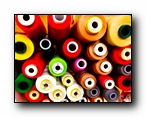 La Nouba is the meeting of two worlds poles apart: the fantastic world of
the circus artists - the Cirques, sporting bright, fluorescent colors - and that of
the Urbans, who wear dark, monochromatic outfits. Dominique Lemieux created 30
different costume concepts, blending historical and traditional circus attire with
original contemporary styles, and drew at least 10 different designs for each costume
concept. Although those designs were pared down by the time of La Nouba's debut, the
wardrobe department still handles over 300 costumes and headpieces every day. That's
because some principal characters have several costume layers, many of whom undergoing
a metamorphosis indicated by a dramatic costume change (revealed as the tale unfolds).
An example of this transformation can be seen with the Urbanites: they begin in ark,
muted blues, reds and greens and end up in white, billowing, and fairy-like outfits.
La Nouba is the meeting of two worlds poles apart: the fantastic world of
the circus artists - the Cirques, sporting bright, fluorescent colors - and that of
the Urbans, who wear dark, monochromatic outfits. Dominique Lemieux created 30
different costume concepts, blending historical and traditional circus attire with
original contemporary styles, and drew at least 10 different designs for each costume
concept. Although those designs were pared down by the time of La Nouba's debut, the
wardrobe department still handles over 300 costumes and headpieces every day. That's
because some principal characters have several costume layers, many of whom undergoing
a metamorphosis indicated by a dramatic costume change (revealed as the tale unfolds).
An example of this transformation can be seen with the Urbanites: they begin in ark,
muted blues, reds and greens and end up in white, billowing, and fairy-like outfits.
| |
The costumes for La Nouba were created in a record eight-week period from October 24 to
December 23, 1998 at the costume workshop located in the Cirque du Soleil theater.
|
To take into account the darkness of the set, the costumes were drawn on a black
background using brightly colored glow-in-the-dark pencil crayons. Their filigreed
florescent outlines give them an air of lightness, like lace. Dark fabrics with
fluorescent color accents are also used to provide high-contrast images with the
addition of black lights. For example: The German Wheel costumes were designed to
resemble marionettes while also highlighting the artists' anatomy. The Flying
Trapeze costumes were also created in similar vain: they are both tribal and androgynous
with elaborate collars, head ornaments, and tutu skirts (for the male performers).
Both glow in black light. Not everybody was excited about wearing them though:
"Normally, the artists are willing to go beyond what they would normally do,"
Lemieux muses. "In La Nouba, we had created these transvestite characters for the
Russians to play, to give the show a cabaret feel. And they really, really resisted
doing it! But, in the end, they agreed: and they do a wonderful job!"
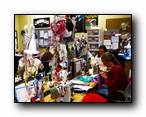 Once the costumes are designed it's the Wardrobe Department's job to create and service the
costumes. La Nouba's wardrobe department employs ten technicians to custom-dye the costume materials
for the show. These include fabric, real and synthetic hair, feathers, horsehair, leather,
and more. The designs on the costumes for the diabolo act are fashioned out of rope
applique, for example. Silk is also used: Like traditional Pierrot clowns, Les Cons
are dressed head to toe in white - symbolizing naivety and innocence. The costumes of
this quirky quartet are made of silk and decorated with beads. You'll even find the
at-sign (@) and other typographical symbols associated with computer technology -
distinctive shapes denoting the advent of e-commerce - were integrated into some of
the costumes. As in all Cirque du Soleil productions, plaster head molds were cast for
each of the artists to insure that their wigs, masks and headpieces fit perfectly. This
process takes about four hours per head. A total of four different wig-styles were
created for La Nouba, and each wig takes one person approximately 70 hours to make. And
while it's hard work, they've created lasting characters for us to enjoy...
Once the costumes are designed it's the Wardrobe Department's job to create and service the
costumes. La Nouba's wardrobe department employs ten technicians to custom-dye the costume materials
for the show. These include fabric, real and synthetic hair, feathers, horsehair, leather,
and more. The designs on the costumes for the diabolo act are fashioned out of rope
applique, for example. Silk is also used: Like traditional Pierrot clowns, Les Cons
are dressed head to toe in white - symbolizing naivety and innocence. The costumes of
this quirky quartet are made of silk and decorated with beads. You'll even find the
at-sign (@) and other typographical symbols associated with computer technology -
distinctive shapes denoting the advent of e-commerce - were integrated into some of
the costumes. As in all Cirque du Soleil productions, plaster head molds were cast for
each of the artists to insure that their wigs, masks and headpieces fit perfectly. This
process takes about four hours per head. A total of four different wig-styles were
created for La Nouba, and each wig takes one person approximately 70 hours to make. And
while it's hard work, they've created lasting characters for us to enjoy...



Le Promeneur (The Stroller)
What’s going on in the head (under the hat) of the lonely little Walker?
Back and forth he goes, never stopping... except at very specific moments, for
reasons known to him alone. With a happy-go-lucky shuffle in his step, this character
sees the world through playfullness and happiness. Complete with a green bowler's hat,
he'll warm his way into your heart and soul, and bring a smile to your face.
Le Titan (The Titan)
Le Titatn -- He's our resident strong man. You can spot him by his bald
head, grey robe and mechanical leg kicking walk. He's a solitary figure,
unfriendly and threatening. He marches assertively through the world of La
Nouba, like a nightmare waiting to take over a sweet dream.
La femme de Ménage (The Cleaning Lady)
Once upon a time, there was an Attic that had been abandoned for many years.
Among the cobwebs, the forgotten toys, the trunks bursting with memories, strange
and fabulous characters lay dormant, just waiting to take up their tale. All she
had to do was open the door. As the door swung shut behind her, Petite Madame
(who had merely come to do a little cleaning), found herself beset on all sides
by a mad reel of the possible and the impossible, dream and reality, the wonderful
and the everyday. (Also known as "La Femme de Ménage")
Les Cons (The Nuts)
Once upon a time there were four Nuts. Four Nuts that no one could see, but
they themselves saw everything. Nuts they might be, but mad they were not. And
these Nuts had but one idea in their heads: to mind everyone’s business but their
own, to disobey, to muddle lines, stories, destinies . . . and to have fun! Noted
by their bald heads and white gownd, these nuts are mischievous, innocent characters
that seems to exist between realities. You'll spot them immediately... sometimes
screaming their heads off! Inspired by the Pierrot or classical clown, Les Cons
are dressed simply in white to signify their naïve and innocent character.
L'Oiseau (The Green Bird)
Originally known as Le Pantin, or The Puppet, The Green Bird has
escaped her cage, and desperately wants to fly. But she can't; she is too
awkward. She remains trapped in the urban world like a marionette with tangled
strings.
Les Danseurs (The Dancers)
Imagine a classic love story with the passion and intensity of Romeo and
Juliet. Only now, the relationship is between a Pierrot clown and a lost ballerina.
Their love, like their dance, is a never-ending story filled with desire, fear and
a longing for more.
The Pierrot Acrobat
The Acrobatic Pierrot appears up on the mountain, on the wall at the
End of the World, on the Rocks, and at the heart of the action. Agile and nimble,
within a flash of folly you'll miss him as he turns, flips, twists and flies
across your view. He is called the Red Pierrot, after a species of
butterfly. Like his namesake, he flits about the stage, somehow
cross-pollinating his fellow acrobats. (His red flame costume is made of
pleated silk and stretch velour.)
Clowns: The Pablos (2014+)
Purple Pablo and Orange Pablo are sometimes friends, sometimes enemies. Guiding
guests on their colorful journey through this new place called La Nouba. Enhancing
a world that mesmerizes and mystifies. (Prior to joining La Nouba, this clown pair
were featured in Alegria.)
|
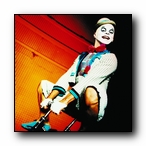
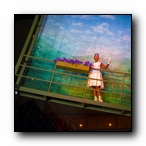
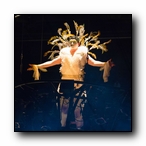
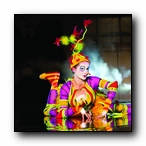
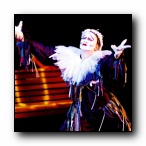
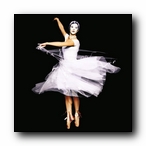
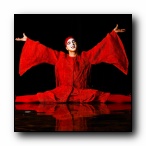
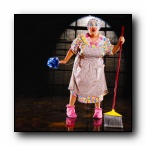
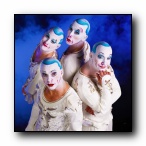
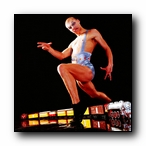
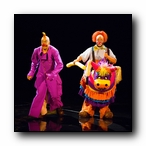
|
|

![]()






